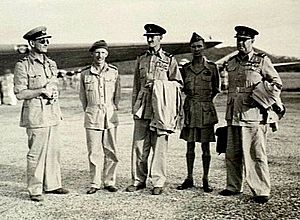Hugh Saunders (RAF officer) facts for kids
Quick facts for kids
Sir Hugh Saunders
|
|
|---|---|

Hugh Saunders as Air Officer Commanding No. 11 Group during the Second World War
|
|
| Nickname(s) | Dingbat |
| Born | 24 August 1894 Germiston, South Africa |
| Died | 8 May 1987 (aged 92) Ringwood and Fordingbridge, England |
| Allegiance | South Africa United Kingdom |
| Service/ |
South African Army (1914–17) Royal Air Force (1917–53) |
| Years of service | 1914–1953 |
| Rank | Air Chief Marshal |
| Commands held | Air Forces Western Europe (1951–53) Inspector-General of the RAF (1949–51) Air Member for Personnel (1947–49) Bomber Command (1947) RAF Burma (1945–47) No. 11 Group (1942–44) Chief of the RNZAF Air Staff (1939–41) No. 45 Squadron (1932–35) |
| Battles/wars | First World War Iraqi revolt Second World War |
| Awards | Knight Grand Cross of the Order of the Bath Knight Commander of the Order of the British Empire Military Cross Distinguished Flying Cross & Bar Military Medal Mentioned in Despatches Commander's Cross with Star of the Order of Polonia Restituta (Poland) Commander of the Legion of Merit (United States) Officer of the Legion of Honour (France) Grand Cross of the Order of the Dannebrog (Denmark) |
Sir Hugh William Lumsden Saunders (born August 24, 1894 – died May 8, 1987) was a brave pilot from South Africa. He became a very important leader in the Royal Air Force (RAF), which is the United Kingdom's air force. He was known for his courage and leadership during both the First World War and the Second World War.
Contents
Early Military Career

Hugh Saunders joined the army in South Africa in 1914. This was at the start of the First World War. He later became a pilot in the Royal Flying Corps. This was the air force before the RAF was created.
He flew many missions and was very skilled. He even flew alongside another famous South African pilot, Andrew Beauchamp-Proctor. Saunders was known as a "triple ace" because he shot down 15 enemy planes. This was a huge achievement for a pilot.
In 1932, he was put in charge of No. 45 Squadron. This was an important step in his career.
Leadership During World War II
When the Second World War began, Saunders took on even bigger roles. First, he worked as the Chief of Staff for the Royal New Zealand Air Force. This meant he helped manage their air force.
Later, he moved to RAF Fighter Command in 1942. He then became the leader of No. 11 Group. This group was very important for defending Britain from enemy air attacks. In 1944, he was put in charge of personnel at the Air Ministry. This meant he helped manage all the people in the RAF.
After the War
After the war ended, Saunders continued to serve in high-ranking positions. He led the RAF in Burma. Then, in 1947, he became the head of RAF Bomber Command. This command was responsible for all bombing missions.
He also became the Air Member for Personnel, helping to look after all RAF staff. Later, he was the Inspector-General of the RAF. This role meant he checked how well the RAF was doing. In 1951, he became Commander-in-Chief of Air Forces in Western Europe. He retired from the RAF in 1953.
Helping Denmark's Air Force
After retiring, Saunders was asked to help the Royal Danish Air Force (RDAF). They were having many accidents with their planes. In 1954, he became a special advisor to Denmark's Minister of Defence.
Saunders helped to reorganize the RDAF. He created a new main headquarters called Tactical Air Command Denmark. He also improved their training programs. Because of his help, the number of accidents in the RDAF went down. He stayed in Denmark until 1956. For his great work, he received a special award from Denmark.

